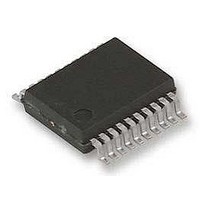ATA5743P6-TKQY 19 Atmel, ATA5743P6-TKQY 19 Datasheet - Page 5

ATA5743P6-TKQY 19
Manufacturer Part Number
ATA5743P6-TKQY 19
Description
RF Receiver UHF ASK / FSK Receiver
Manufacturer
Atmel
Type
Receiverr
Datasheet
1.ATA5743P3-TGQY.pdf
(43 pages)
Specifications of ATA5743P6-TKQY 19
Package / Case
SSO-20
Operating Frequency
449 MHz
Operating Supply Voltage
4.5 V to 5.5 V
Maximum Operating Temperature
+ 105 C
Minimum Operating Temperature
- 40 C
Mounting Style
SMD/SMT
Noise Figure
7 dB
Lead Free Status / RoHS Status
Lead free / RoHS Compliant
4. RF Front-end
4839B–RKE–08/05
The RF front-end of the receiver is a heterodyne configuration that converts the input signal into
a 1 MHz IF signal. As seen in
Amplifier), an LO (Local Oscillator), a mixer, and an RF amplifier.
The LO generates the carrier frequency for the mixer via a PLL synthesizer. The XTO (crystal
oscillator) generates the reference frequency f
erates the drive voltage frequency f
and is then divided by 64. The divided frequency is compared to f
detector. The current output of the phase frequency detector is connected to a passive loop filter
and thereby generates the control voltage V
is controlled in a way that f
the following formula: f
The XTO is a one-pin oscillator that operates at the series resonance of the quartz crystal. As
demonstrated in
value of that capacitor is recommended by the crystal supplier. The value of C
mized for the individual board layout to achieve the exact value of f
designing the system in terms of receiving bandwidth, the accuracy of the crystal and the XTO
must be considered.
Figure 4-1.
The passive loop filter connected to pin LF is designed for a loop bandwidth of B
This value for B
the appropriate loop filter components to achieve the desired loop bandwidth. If the filter compo-
nents are changed for any reason, please note that the maximum capacitive load at pin LF is
limited. If the capacitive load is exceeded, a bit check may no longer be possible since f
not settle in time before the bit check starts to evaluate the incoming data stream. Self polling
will also not work in that case.
f
mula: f
To determine f
frequency is f
is tuned by the crystal frequency f
f
LO
LO
. This relation is dependent on the logic level at pin MODE.
is determined by the RF input frequency f
LO
= f
RF
IF
LO
PLL Peripherals
- f
= 1 MHz. To achieve a good accuracy of the filter’s corner frequencies, the filter
Loop
, the construction of the IF filter must be considered at this point. The nominal IF
IF
Figure
exhibits the best possible noise performance of the LO.
XTO
4-1, the crystal should be connected to GND via a capacitor C
= f
LO
/64 is equal to f
LO
Figure 3-2 on page
/64.
LFGND
LFVCC
DVCC
XTO
LF
XTO
LO
. This means that there is a fixed relation between f
for the mixer. f
V
V
S
S
XTO
LF
RF
C9
XTO
for the VCO. By means of that configuration, V
. If f
R1
and the IF frequency f
4, the front-end consists of an LNA (Low-Noise
. The VCO (voltage-controlled oscillator) gen-
LO
is determined, f
C10
LO
C
L
is dependent on the voltage at pin LF,
C9 = 4.7 nF
C10 = 1 nF
R1 = 820
XTO
XTO
XTO
IF
and hereby of f
by the phase frequency
can be calculated using
using the following for-
Figure 4-1
ATA5743
L
should be opti-
Loop
= 100 kHz.
LO
. When
LO
shows
L
IF
. The
can-
and
LF
5














